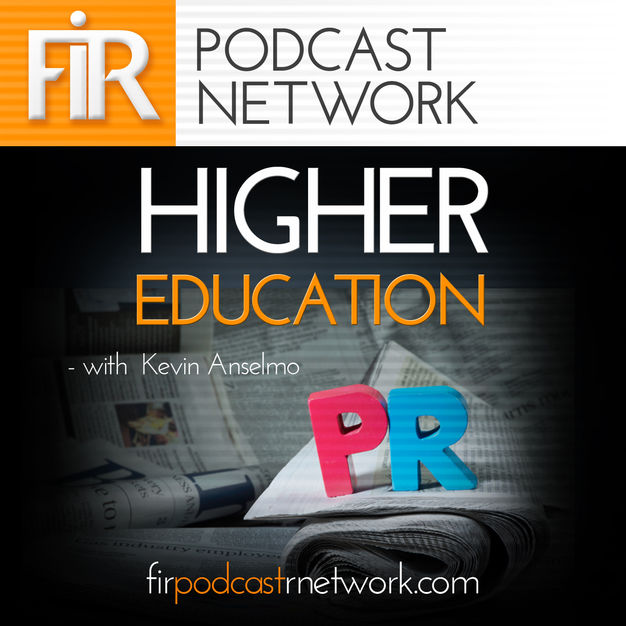
FIR on Higher Education
Kevin Anselmo
From recruiting students to getting media coverage, higher education faces unique communication challenges. Kevin Anselmo reports the news and conducts interviews with thought leaders in this bi-weekly podcast.
- 42 minutes 44 secondsFIR on Higher Education #67: How Professors Can Use Comms Tools to Enhance the Student Experience
 How can professors – regardless of field – be more creative? What are ways to use digital communications tools to enhance the student experience? How can professors become co-creators in the learning process with their students? How do we prepare students for jobs that don’t exist in the future due to advances in technology?
How can professors – regardless of field – be more creative? What are ways to use digital communications tools to enhance the student experience? How can professors become co-creators in the learning process with their students? How do we prepare students for jobs that don’t exist in the future due to advances in technology?These are among the questions that we delved into on episode 67 of FIR on Higher Education. This particular episode was a rare live show in which I interviewed three different public relations professors who were in attendance for the EUPRERA conference in London (EUPRERA is the European Public Relations Education and Research Association).
Public relations professors Ai Zhang (Stockton University), Karen Freberg (University of Louisville) and Sabrina Page (Walters State Community College) shared lots of value in a fun setting over coffee. Eavesdrop on our conversation!
The post FIR on Higher Education #67: How Professors Can Use Comms Tools to Enhance the Student Experience appeared first on FIR Podcast Network.
27 October 2017, 2:44 pm - 27 minutes 34 secondsFIR on Higher Education #66: Perhaps You Should Communicate Your Research via Instagram?
Communicating research visually can be challenging. I have struggled to find really compelling examples of academics / researchers who are effective at using Instagram to communicate research. I was therefore grateful to come across the world of Paige Jarreau, a science communication specialist for the Louisiana State College of Science and previously a postdoctoral researcher studying and teaching science communication. She also leads Instagram training workshops, and on episode 66 of FIR on Higher Education, I interviewed her to discuss best practice and tips to consider.

Paige Jarreau
Here are some of the insights she shared.
Why Instagram
To preface her remarks, Paige makes the important point that perhaps you shouldn’t use Instagram. You need to be selective. But here are some points to consider:– If your target audience is students, Instagram is potentially a great way to reach them. It allows you to make your science and research more accessible.
– It is not as much of a commitment as blogging, allows you to provide more depth than Twitter and is not as private as Facebook.What if the Research Isn’t “Visual”?
“It takes practice,” says Paige. “You need to look around yourself in fresh ways and think about how to make what you do visual.”One example is a reflection image a scientist took to make their data look unique. Paige has come across researchers who use data visualization in unique ways, or a researcher who communicated compound chemistry through drawings of molecules.
“Think about how to humanize your work,” advises Paige.
Tools to Consider Leveraging
- Boomerang App – creates captivating mini videos that loop back and forth
- Canva.com – graphic design made easy.
- VSCO App – provides filters.
- AfterLight App – powerful photo editing tool.
- Layout App – Allows you display multiple photos in one Instagram post.
Examples of Other Researchers Who Use Instagram
Paige recommends taking a look at the work of PondLife_PondLife who uses Instagram to take amazing pictures and videos of microscopic organisms in ponds. “At the surface, she might have said I just sit in front of a microscope – what is their to show? Instead she has chosen to use the device of science – a mircoscope – to take pictures and it never gets old. It is amazing!” Also of note is the account of StylishStreaking which visually communicates research about diseases.Instagram Live and Stories
The opportunity to live stream and/or leverage Instagram Stories may be intimidating and certainly isn’t for everyone, but it is an option. Two individuals Paige noted who use Instagram Stories and Instagram Live are Science.Sam and BiologistImogene.“They are both effective at taking people on a journey of doing science every day,” Paige said.
Practical Tips
- Consider using longer form text – almost like a blog post – to accompany each visual and explain your work. For example, Paige runs a feature called “Monday Motivation” for the LSU College of Science in which a researcher answers a particular question related to his/her science. This write-up accompanies each visual. (Instagram has a character limit of 2,500 characters).
- Don’t be afraid to use lots of hashtags. It will help you be found in searches.
- Try to incorporate it into your daily process. Many researchers need pictures any way for a research paper or poster. Snap an extra picture for Instagram. This can be a way to make it work as part of your every day community.
- Find communities – other scientists or students for example – to keep you motivated (among other benefits). The best way to find these communities is by searching through hashtags.
Instagram Research Project via Experiment.com
Experiment.com is a platform for funding scientific discoveries (it is similar in nature to Kickstarter). Paige and some of her colleagues are looking to receive funding to research the topic of how the public perceives scientists who use Instagram. It aims to provide hard data on if people will trust scientists more, for example. The team will conduct some experiments to get to the core of how Instagram pictures can help predict people’s perceptions of scientists. More information is at experiment.com/scientistselfies. The hashtag they are using to generate community around this is #ScientistsWhoSelfie.The post FIR on Higher Education #66: Perhaps You Should Communicate Your Research via Instagram? appeared first on FIR Podcast Network.
16 August 2017, 3:46 am - 18 minutes 58 secondsFIR on Higher Education #65: Perhaps It’s Time to Revamp Your Bio?
An academic, researcher or expert’s bio is important real estate that often times is neglected. A compelling bio can go a long way towards supporting strategic goals, both at the individual and organizational levels. On episode 65 of FIR on Higher Education, I highlight common mistakes to avoid and interesting examples to consider.
Links highlighted on the episode:
- Example of a scannable bio: the faculty bios for The Graduate School of Business at Stanford University (take a look at Dr. Michal Kosinski’s bio).
- Example of a bio txt incorporates tabs: Professor Mark Hall for the Wake Forest University School of Law (bio).
- An example of a professor incorporating links to courses is Karl Moore of McGill University. On the research side, professor Steve Adie from Cornell Engineering includes a link from his official bio that goes to a dedicated site focused on his research of optical imaging methods.
- Faculty at IMD, a business school in Switzerland and my former employer, have links to downloadable images on their bios.
- Sara Goldrick Rab of Temple University’s College of Education wrote her bio in the first person and incorporated a call to action.
- A bio is a good way to connect to institutional marketing communications goals, as is done by The Center for Creative Leadership (example of a bio).
Have other thoughts to share about what should be incorporated into a bio? Share your opinions on the FIR Podcast Network Facebook page.
If you are interested in more insights on how to communicate effectively as an academic, you can take a look at my book “Maximize Your Impact – How Academics Can Communicate Knowledge through Traditional and Digital Media“. You can download a free chapter at this link.
The post FIR on Higher Education #65: Perhaps It’s Time to Revamp Your Bio? appeared first on FIR Podcast Network.
16 May 2017, 5:31 pm - 28 minutes 1 secondFIR on Higher Education 64: Communicating Research via Video
 How do you communicate complex ideas via video?
How do you communicate complex ideas via video?If you are a researcher or communicator, perhaps this is a question on your mind. On episode 64 of the FIR on Higher Education podcast, guest Jonathan Ezer offers advice on how to communicate your research via video.
Jonathan founded a company that helps researchers, scientists, innovators and educators communicate their work via video. He works with researchers and educators to disseminate research findings, promote new initiatives and eplain complex ideas in a way that resonates.
“The biggest mistake is not thinking about the audience up front,” said Jonathan. “I will ask a client and they will say: ‘Well there are several. There are prospective students. There are current patients. There are are funders, policy makers and the research community.’ Writing a video for so many people is really, really tough.”
Ezer also warned about the dangers of writing too academic. “Short, punchy sentences really work best for these sorts of videos,” he said.
Have a listen to the interview for his other tips.
About Jonathan Ezer
Jonathan is the founder of Kindea Labs, an animation studio for researchers, scientists, innovators and educators. Jonathan holds a PhD from the London School of Economics. He’s passionate about intellectual ideas, and has 10 years of management consulting experience.The post FIR on Higher Education 64: Communicating Research via Video appeared first on FIR Podcast Network.
14 March 2017, 9:40 pm - 4 minutes 38 secondsFIR on Higher Education – Update
This short episode is an update about FIR on Higher Education. In summary, FIR on Higher Education is going on a bit of a hiatus for the next few months. I share a bit of the rationale on this episode. If you don’t care about that, but are interested in accessing content focused on higher education marketing / communications, then I encourage you to access any of the 63 previous episodes of the podcast. The majority of these episodes are evergreen – they consist primarily of interviews with different experts sharing their thoughts on various aspects of higher education marketing and communications.
The post FIR on Higher Education – Update appeared first on FIR Podcast Network.
28 October 2016, 8:49 pm - 26 minutes 56 secondsFIR on Higher Education #63: How to Integrate Marketing Automation at your School
 Has your school integrated a marketing automation program?
Has your school integrated a marketing automation program?If not, or if you have not been successful with your marketing automation efforts, you will want to listen to the insights from Christie Campbell, Associate Vice President of Marketing at St. Edward’s University. Christie spear-headed St. Edward’s marketing automation program two years ago. This year, St. Edward’s won the Best Marketing Automation in Content Marketing by the Content Marketing Institute. On episode 63 of FIR on Higher Education, Christie discusses her school’s success with marketing automation. She outlines what went into St. Edward’s University winning the Content Marketing Institute award and provides input on topics such as:
– Creating content related to the audiences’ needs first.
– How to structure a team
– Thinking through purchasing marketing automation services
– Generating emails
– Using marketing automation to glean insights on the customer experience
About Christie Campbell
Christie Campbell is a leader of the St. Edward’s University Marketing Office, which is responsible for communicating the St. Edward’s University story to increase engagement, attract resources and achieve the university’s goals.
The post FIR on Higher Education #63: How to Integrate Marketing Automation at your School appeared first on FIR Podcast Network.
4 October 2016, 4:07 pm - 32 minutes 32 secondsFIR on Higher Education #62: How Gettysburg College Increased Its Visibility Through Medium
Have you dabbled with Medium, the online publishing tool owned by Twitter? Not happy with your success? If that is the case for you and you want to discover how to change this narrative, then you will want to listen to episode 62 of FIR on Higher Education. My guests are two marketing / communications professionals from Gettysburg College: Carina Sitkus and Paul Redfern.
Carina and Paul recently wrote an excellent article on the Inside Higher Education blog entitled “Success with a New Medium”. The piece outlines how Gettysburg College has extended its visibility, particularly noting that the piece “The 10 Commandments for New College Students,” received 8.4K organic views at the time of publication. On the podcast, Paul and Carina delve into the strategies and tactics that have contributed to the school’s success. Among the topics addressed are:
– Background on Medium
– The pros and cons of creating content on an external platform as opposed to a more traditional “owned” property
– The value of the annotation tool and responses
– How publishing to different publications works and can dramatically increase readership
– The potential for individual academics to use Medium to build up their own thought leadershipAbout Paul Redfern
 Paul Redfern was promoted to Executive Director of Communications and Marketing at Gettysburg College in June 2011. He is responsible for managing the Office of Communications and Marketing and for staffing, and implementing a comprehensive communications and marketing program that will enhance the College’s visibility and reputation as well as promote greater understanding and support by effectively presenting and interpreting the College’s distinctions, achievements, aspirations, needs, and values to all members of the College community and to the general public.
Paul Redfern was promoted to Executive Director of Communications and Marketing at Gettysburg College in June 2011. He is responsible for managing the Office of Communications and Marketing and for staffing, and implementing a comprehensive communications and marketing program that will enhance the College’s visibility and reputation as well as promote greater understanding and support by effectively presenting and interpreting the College’s distinctions, achievements, aspirations, needs, and values to all members of the College community and to the general public.During the 2010-11 year he served as Director of Web Communications and Marketing responsible for developing an integrated marketing plan as well as coordinating print and digital marketing campaigns for the College.
From June 2006 until June 2010 he served as Director of Web Communications and Electronic Media at Gettysburg College. He provided leadership and support to the College community through the development and implementation of the web, electronic communications, and video as well as social media and Web 2.0 initiatives. He previously was Assistant Director of Admissions and Coordinator of Electronic Media at Gettysburg College, where his duties focused on admissions communications and technology. Prior to that, he worked for two years in the Athletic Department at Gettysburg, serving as Assistant Basketball Coach.
He is active in numerous professional organizations including (CUPRAP) the Association of Communicators in Education and (CASE) the Council for the Advancement and Support of Education. He has served on the CASE District II conference executive committee and board as well as the conference marketing and program committees. He previously has served on the Technology Committee for (PACAC) the Pennsylvania Association for College Admissions Counseling.
Paul and his wife Leigh-Anne reside in Gettysburg, PA and have two sons and one daughter. He is a former member of the Upper Adams School District Board of Directors and he currently sits on the Canner Educational Fund Advisory Board.
About Carina Sitkus
 Carina Sitkus is the senior assistant director of communications at the College. In this role she is responsible for crafting homepage and centerpiece stories highlighting the great work of Gettysburg students, faculty, and alumni, as well as working with departments and distinctive programs to implement strategic marketing and communications initiatives. Prior to Gettysburg, Carina was a teacher and previously led communications initiatives for a growing network of schools in Northern Rhode Island.
Carina Sitkus is the senior assistant director of communications at the College. In this role she is responsible for crafting homepage and centerpiece stories highlighting the great work of Gettysburg students, faculty, and alumni, as well as working with departments and distinctive programs to implement strategic marketing and communications initiatives. Prior to Gettysburg, Carina was a teacher and previously led communications initiatives for a growing network of schools in Northern Rhode Island.The post FIR on Higher Education #62: How Gettysburg College Increased Its Visibility Through Medium appeared first on FIR Podcast Network.
19 September 2016, 8:15 pm - 33 minutes 54 secondsFIR on Higher Education #61: Using a Podcast to Sell a Course
 On the FIR on Higher Education podcast, we have discussed how a podcast can be used in higher education to support big-picture objectives. We focused on using podcasts for events (with Donna Papacosta on episode 50) and how a podcast can be used to communicate research to a broader audience (with Chris Rose from the University of Texas Austin on episode 48).
On the FIR on Higher Education podcast, we have discussed how a podcast can be used in higher education to support big-picture objectives. We focused on using podcasts for events (with Donna Papacosta on episode 50) and how a podcast can be used to communicate research to a broader audience (with Chris Rose from the University of Texas Austin on episode 48).On episode 61, we explore the topic of using a podcast to support the sales of a course or program with Victor Jimenez. Victor doesn’t work in a traditional higher education setting. However, like many in the higher education world, he needs to find ways to market and ultimately sell his online courses. Over 3,000 people have purchased his courses and Victor can attribute his popular podcast to a significant percentage of sales.
We specifically explore the following topics:
– The work that goes into building an audience.
– Using the podcast and email marketing hand-in-hand.
– Why you should give away your best content on a podcast and not worry about that saturating your teaching.
– When and how to directly sell a program or course through your podcast
– Mistakes to avoidAbout Victor Jimenez
Victor is a coach and online course creator. His Cycling 360 Podcast has generated 30k –50k downloads per month (over 2 million lifetime downloads).Victor and Kevin are leading a hands-on workshop on podcasting in Durham, North Carolina on November 15th. Learn more.
The post FIR on Higher Education #61: Using a Podcast to Sell a Course appeared first on FIR Podcast Network.
1 September 2016, 12:24 pm - 28 minutes 20 secondsFIR on Higher Education #60: How to Create a Compelling Lead Magnet to Support Lead Generation
 Many schools and programs seek ways to increase enrollment numbers. An optimal way to generate new leads is by creating a compelling lead magnet: offering a valuable form of content in exchange for a new user’s email address and other contact details.
Many schools and programs seek ways to increase enrollment numbers. An optimal way to generate new leads is by creating a compelling lead magnet: offering a valuable form of content in exchange for a new user’s email address and other contact details.A great example of an effective lead magnet within higher education is IMD’s Global Leader Index. (IMD is a business school in Switzerland and my former employer). The Global Leader Index is a survey in which individuals sign up and answer a series of questions. At the completion of the survey, respondents can see how their leadership skills compare to others. Over 12,000 individuals have completed the survey. The school has used this survey to support various aspects of its sales, marketing and communications. The survey has also been used by a center within the school for research.
James Henderson, a professor at IMD and a member of the management team responsible for programs and innovation, provided the inside story about the Global Leader Index. Among the topics he discussed are:
- How to create a compelling lead magnet
- When to begin incorporating sales
- Tips on promoting a lead magnet
- The value of conversation-based marketing
- The importance of collaborating across an institution so various departments can benefit from the content initiative.
If you work in communications, admissions or marketing, or if you are senior leader concerned about yield rate, then you won’t want to miss this episode!
About James Henderson
James Henderson is Professor of Strategic Management at IMD. Prior to joining IMD, he was an Associate Professor of Strategic Management at Babson College and Babson School of Executive Education, based in Boston, MA.
His areas of special interest are:
– Strategy under uncertainty
– Competitive strategy
– Corporate strategy
– Strategy execution
The post FIR on Higher Education #60: How to Create a Compelling Lead Magnet to Support Lead Generation appeared first on FIR Podcast Network.
17 August 2016, 12:08 pm - 24 minutes 54 secondsFIR on Higher Education #59: How to Think Through Your Media Monitoring
 The success of a PR program hinges on monitoring. We need to have the tools in place to know not only what is being said about our brand, but also what is being communicated about our industries, competitors and audiences. We then need to have the appropriate systems to share intelligence with our different stakeholders, whether it be senior leadership, faculty, alumni and the communications team.
The success of a PR program hinges on monitoring. We need to have the tools in place to know not only what is being said about our brand, but also what is being communicated about our industries, competitors and audiences. We then need to have the appropriate systems to share intelligence with our different stakeholders, whether it be senior leadership, faculty, alumni and the communications team.Episode 59 of FIR on Higher Education focuses on the best practices to consider in evaluating or setting up a media monitoring program. Chip Griffin, founder of the media monitoring service Custom Scoop and now the North America CEO for the media intelligence service CARMA, shares his insights as a thought leader in this particular space. Among the topics we address are:
- The importance of media monitoring as one thinks about strategic PR measurement
- Best practice in setting up a media monitoring operation and mistakes to avoid
- How to use media monitoring to engage alumni
- How to evaluate the different offerings on the market to suit your budget
About Chip Griffin
Chip Griffin believes in the power of words and the value of technology in communications. He currently serves as North American CEO and global head of marketing and product development for CARMA, a global media intelligence firm.
Previously, he was the Chairman & CEO of CustomScoop, a media monitoring and measurement service he co-founded in 2000 and sold to CARMA in 2015.
As a serial entrepreneur, Chip takes a no-nonsense approach that challenges conventional wisdom and identifies emerging trends. In recognition of his expertise, publications and event organizers frequently call on him to share his insight. A longtime innovator, Chip was recruited from his job on Capitol Hill to serve as CEO of an online media company when he was just 23 years old. He also has the distinction of being one of the first individuals to hold the title of Chief Digital Officer of a major public relations firm. A graduate of American University, he serves as Immediate Past President of the AU Alumni Association and a member of the School of Public Affairs Advisory Council.
The post FIR on Higher Education #59: How to Think Through Your Media Monitoring appeared first on FIR Podcast Network.
30 July 2016, 1:46 am - 43 minutes 19 secondsFIR on Higher Education #58: Shel Holtz on Developing Employee Advocacy Programs
 As the Edelman Trust Barometer details, the public in general is skeptical about messages coming from PR professionals or senior leadership. However, employees and subject matter experts are trusted, according to the Edelman survey. It should therefore be incumbent on schools, centers and institutions overall to develop employee advocacy programs. Imagine the impact that can be generated when you have individuals who can share the brand’s content, respond appropriately to complaints and advocate for the organization to their respective networks.
As the Edelman Trust Barometer details, the public in general is skeptical about messages coming from PR professionals or senior leadership. However, employees and subject matter experts are trusted, according to the Edelman survey. It should therefore be incumbent on schools, centers and institutions overall to develop employee advocacy programs. Imagine the impact that can be generated when you have individuals who can share the brand’s content, respond appropriately to complaints and advocate for the organization to their respective networks.Communications expert Shel Holtz discusses this topic on episode 58 of FIR of Higher Education. An organizational communications expert and the founder of the FIR Podcast Network, Shel shared some best practice, including:
- How communicators can facilitate the process
- Tools to leverage
- How to motivate colleagues to take part
- The importance of training in the process
- The role of culture
In addition, we concluded by going through a mini example of a advocacy program that Shel led with Pepsi.
There are many lessons that higher education audiences can apply from some of the insights that Shel shared during the podcast.
About Shel Holtz
Shel Holtz, ABC (Accredited Business Communicator), is principal of Holtz Communication + Technology. Shel brings to his assignments nearly 35 years of organizational communications experience in both corporate and consulting environments. He is experienced in employee communications, corporate public relations, crisis communications, media relations, financial communications, investor relations, marketing communications and compensation and benefits communications. In addition to integrating technology into communications strategies, his expertise includes strategic communications planning, change management, organizational culture, business initiatives and communications research.
The post FIR on Higher Education #58: Shel Holtz on Developing Employee Advocacy Programs appeared first on FIR Podcast Network.
15 July 2016, 3:28 pm - More Episodes? Get the App
Your feedback is valuable to us. Should you encounter any bugs, glitches, lack of functionality or other problems, please email us on [email protected] or join Moon.FM Telegram Group where you can talk directly to the dev team who are happy to answer any queries.
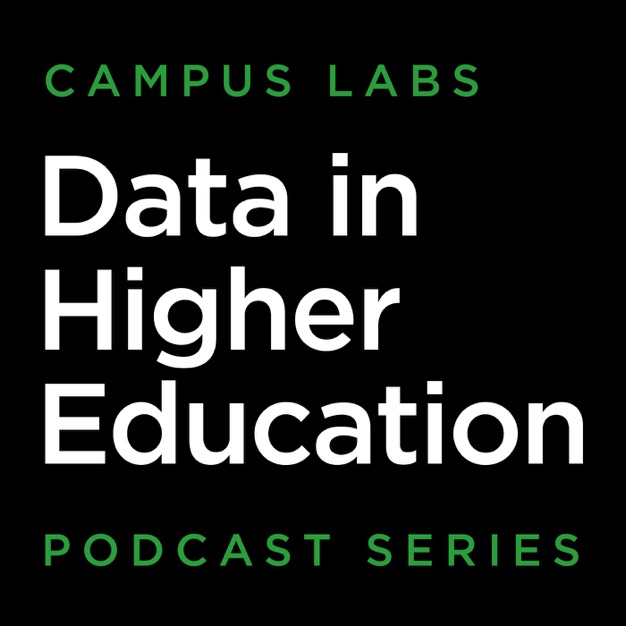 Data in Higher Education
Data in Higher Education
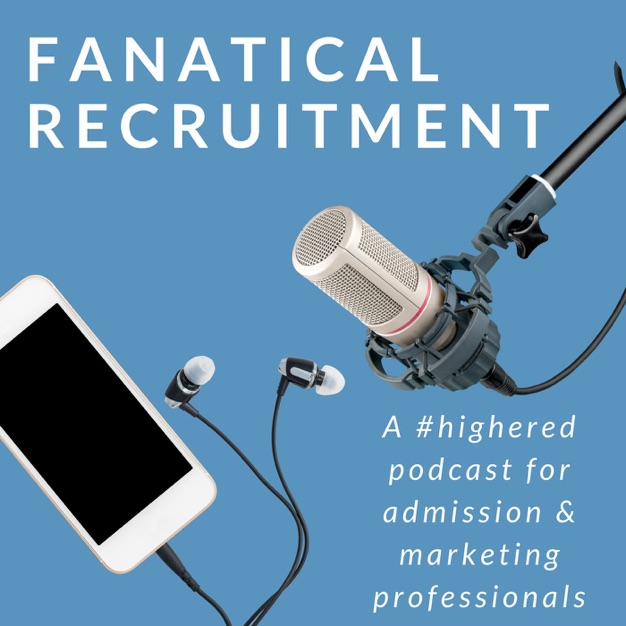 Fanatical Recruitment Podcast
Fanatical Recruitment Podcast
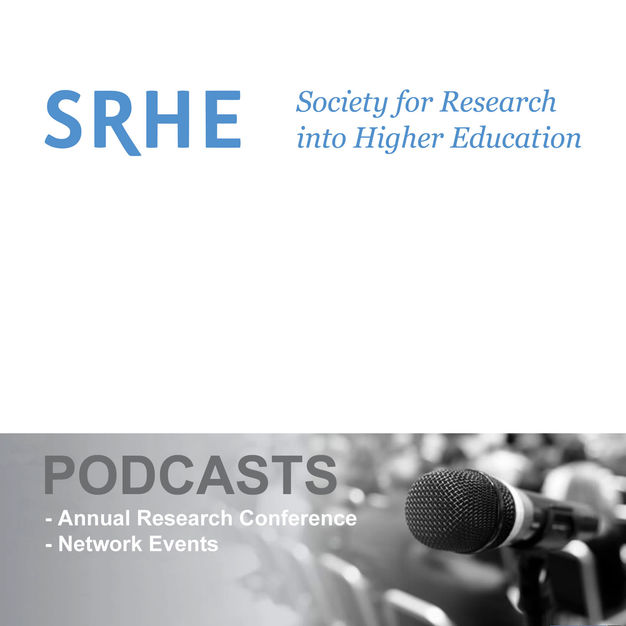 SRHE (Society for Research into Higher Education) Conference And Network Podcasts
SRHE (Society for Research into Higher Education) Conference And Network Podcasts
 Radio Higher Ed
Radio Higher Ed
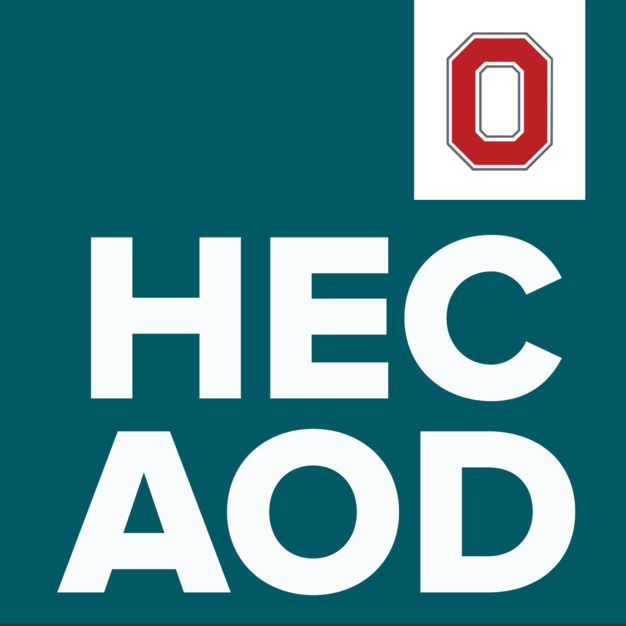 Higher Education Center
Higher Education Center